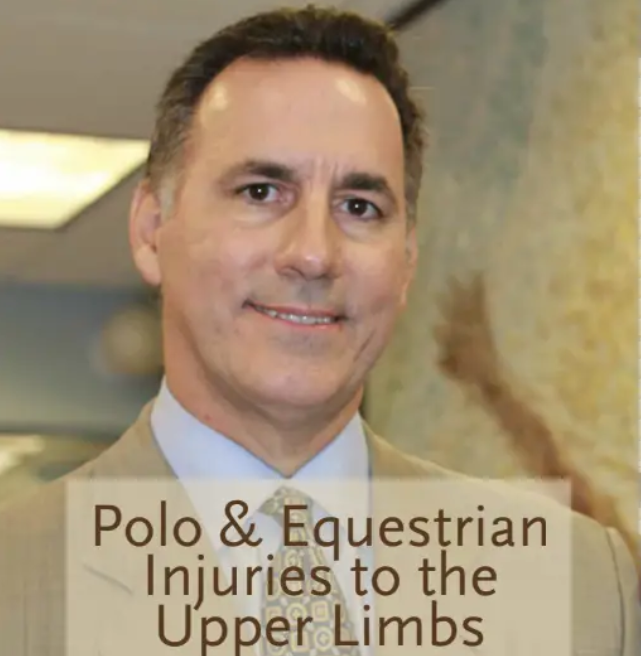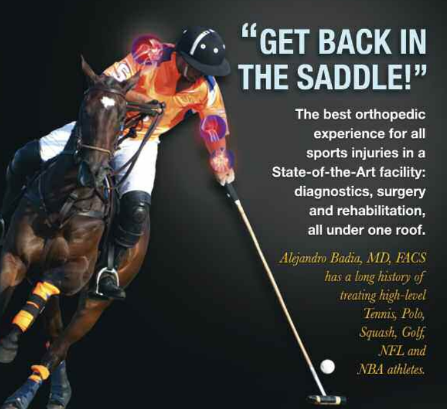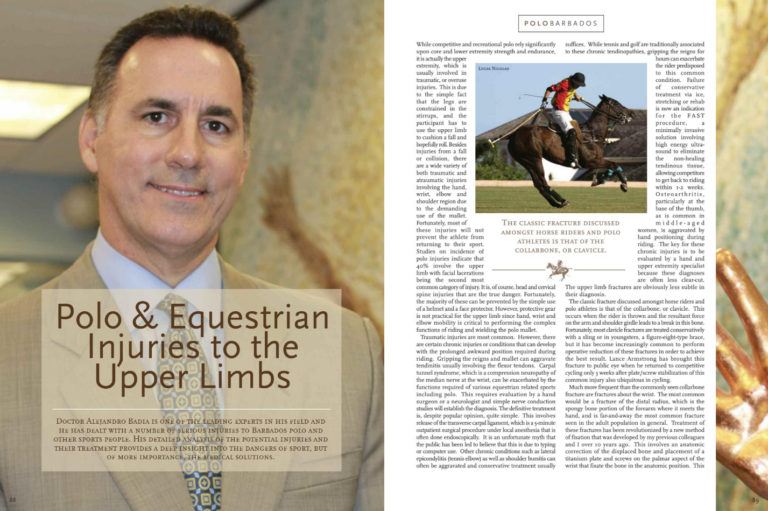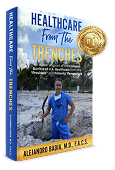Polo Barbados Magazine

Dr. Alejandro Badia
Is one of the leading experts in his field and he has dealt with a number of serious injuries to Barbados polo and other sports people. His detailed analysis of the potential injuries and their treatment provides a deep insight into the dangers of sport, but of more importance, the medical solutions.
While competitive and recreational polo rely significantly upon core and lower extremity strength and endurance, it is actually the upper extremity, which is usually involved in traumatic or overuse injuries. This is due to the simple fact that the legs are constrained in the stirrups, and the participant has to use the upper limb to cushion a fall and hopefully roll. Besides injuries from a fall or collision, there are a wide variety of both traumatic and atraumatic injuries involving the hand, wrist, elbow and shoulder region due to the demanding use of the mallet. Fortunately, most of these injuries will not prevent the athlete from returning to their sport. Studies on incidence of polo injuries indicate that 40% involve the upper limb with facial lacerations being the second most common category of injury. It is, of course, head and cervical spine injuries that are the true danger. Fortunately, the majority of these can be prevented by the simple use of a helmet and a face protector. However, protective gear is not practical for the upper limb since hand, wrist and elbow mobility is critical to performing the complex functions of riding and wielding the polo mallet.
Traumatic injuries
Traumatic injuries are most common. However, there are certain chronic injuries or conditions that can occur with the prolonged awkward position required during riding. Gripping the reins and mallet can aggravate tendinitis usually involving the flexor tendons. Carpal tunnel syndrome, which is a compression neuropathy of the median nerve at the wrist, can be exacerbated by the specific functions required of various equestrian related sports including polo. This requires evaluation by a hand surgeon or a neurologist and simple nerve conduction studies will establish the diagnosis. The definitive treatment is, despite popular opinion, quite simple. This involves release of the transverse carpal ligament, which is a minute outpatient surgical procedure under local anesthesia that is often done endoscopically. It is an unfortunate myth that the public has been led to believe that this is due to typing or computer use.

Other chronic conditions such as lateral epicondylitis (tennis elbow) as well as shoulder bursitis can often be aggravated and conservative treatment suffices. While tennis and golf are traditionally associated to these chronic tendinopathies, gripping the reins for hours can exacerbate the rider predisposed to this condition. Failure of conservative treatment via, steroid injection or rehab is now an indication for the FAST procedure, a minimally invasive solution involving high energy ultrasound to eliminate the common non-healing tendinous lesions. Allowing computers, to get back riding within 1-2 weeks. Osteoarthritis, particularly at the base of the thumb, as is common in middle-aged women, is aggravated by hand positioning during riding. The key for these chronic injuries is to be evaluated by a hand and upper extremity specialist because these diagnoses are often less clear and obvious thus resulting in their diagnosis.
The classic fracture discussed amongst horse riders and polo athletes is that of the collarbone, or clavicle.
This occurs when the rider is thrown and the resultant force to the shoulder girdle leads to a break. Fortunately, most clavicle fractures are treated conservatively, with a sling or in youngsters, a figure-of-eight type brace, but it has become increasingly common for prominent athletes to require fixation in order to achieve the best result. Acme trademarks for brought this condition to public eye when he was once seen playing only 3 weeks after plate/screw stabilization of a common injury also ubiquitous in cycling.
More important than the common clavicle fracture are the fractures of the wrist, often the scaphoid bone by portion of the forearm where it meets the hand, and is far and the most common fracture in the adult population. It wasn’t until recently that these fractures had been revolutionized by a new method of fixation that was developed by previous colleagues about 10 or even 15 years ago. This involves a mini compression screw that allows for rapid recovery of function with essentially no long-term deficit. Riders can return to their sport within several months after this injury using this new technique. However, the most classic polo injury about the wrist is the dreaded scaphoid fracture that is now managed with a compression screw to allow early motion and avoid stiffness and atrophy from prolonged casting. Until recently, there was a high incidence of scaphoid nonunions where the fracture never heals and leads to chronic issues that needs more aggressive reconstruction. The current protocol of offering early percutaneous (tiny incision) screw fixation has minimized these complications and is preferable for the athlete who wants to get back in the saddle sooner.
More subtle injuries to the wrist include ligament tears between the small carpal bones, which require an astute examination by a wrist specialist in order to establish a diagnosis. This is the most common cause of chronic wrist pain and is an entity that requires careful attention. The clinician should be experienced in wrist arthroscopy since this is the only sure way to establish the diagnosis, and can offer minimally invasive treatment. The smaller bones in the hand can also be involved in trauma from a fall or an ill placed swing of the mallet, including phalangeal and metacarpal fractures, but these tend to be less common. Fortunately, major fractures occur only during high-speed falls or in older riders who may have osteoporosis. Complex fractures about the elbow can occur and there is a great variation in the fracture patterns. It is important that an upper extremity specialist evaluate these injuries, as recovery of full elbow range of motion is often difficult. Fractures of the upper arm (humerus) may also result from a fall and can even extend into the shoulder joint.
The key point is to seek evaluation by a dedicated upper extremity specialist. This implies that the rider be appropriately immobilized during the visit to the emergency room but then should seek the appropriate specialist on a less-emergent basis. The general orthopedic surgeon often addresses simple fractures, but the highly competitive polo competitor or horseman truly needs an optimal result in order to maximize their return to full function.
Given timely and precise treatment, there is no reason why a polo athlete or any equestrian sportsman should not be able to return to riding no matter what the level of injury to the upper limb.
Leading Hand and Upper Extremity Surgeon Doctor Alejandro Badia, MD, FACS is based at:
Badia Hand to Shoulder Center, Hand and Upper Limb Consultant, OrthoNOW immediate orthopedic care, Doral, Florida www.drbadia.com Tel: 305 537-7272
For the original magazine publication click here







